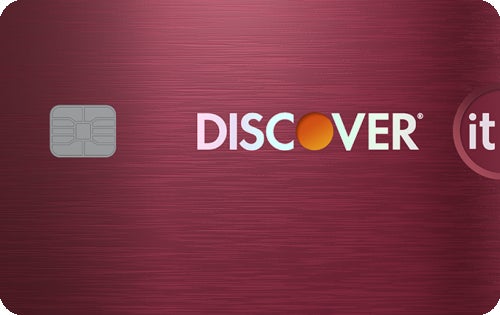For credit card users looking to get the most out of their rewards, the Discover it Cash Back card should catch your eye. If features a high rewards rate for quarterly rotating categories, and Discover will double the rewards cardholders earn during the first year, with no annual fee.
The Discover it Cash Back is the perfect step up from a basic rewards card for consumers who are willing to put in some work to maximize their spending return.

- Earn 5% cash back on everyday purchases at different places each quarter like Amazon.com, grocery stores, restaurants, gas stations and when you pay using PayPal, up to the quarterly maximum when you activate.
- Earn 1% unlimited cash back on all other purchases – automatically.
Discover will automatically match the cashback you earned, dollar for dollar, over those initial 12 months at the end of your first year. There’s no cap on how much Discover matches, and you don’t need to sign up to receive this introductory offer. There’s also no annual fee to worry about.
In addition to the high rewards potential, the card comes with a 0% intro APR for both purchases and balance transfers for an impressive 18 months (then 11.99% to 22.99% variable). That means new purchases won’t accrue interest within that time, and neither will a transferred balance from another credit card.
The rewards structure is based around rotating quarterly spending categories that require activation every quarter. Cardholders will receive 5% cashback (on the first $1,500 spent each quarter, then 1%) for expenses like grocery stores, fitness clubs and gym memberships, gas stations, Target purchases and online shopping. You also earn 1% cashback automatically on all other purchases with no limit.
Pros
- 5% cash back for a variety of different purchases
- 0% intro APR for purchases and balance transfers
- Cashback match
- No annual fee
Cons
- No shopping or travel protections
- $1,500 quarterly spending limit for major rewards
Things to consider
Not a fan of managing which rewards categories are active? This card may not be the one for you. Cardholders must activate the rewards categories each month, otherwise they’ll only earn 1% cashback for those purchases instead of 5%. Rewards drop down to 1%, however, once the quarterly spending limit of $1,500 is reached.
Another note to keep in mind: Discover is not as widely accepted compared to Visa or Mastercard, so you may be more limited in terms of where you can use it. You’ll likely need a backup card in case a restaurant or other establishment doesn’t accept it.
Discover it® Cash Back redemption details
After activating rewards for the quarter and earning 5% cashback (on the first $1,500 spent), there are several things cardholders can do with their cashback. Cardholders can redeem rewards as:
- Statement credits
- Deposits directly into a bank account
- Donations to specific charities
- Amazon purchases
- Gift cards
Gift cards can only be redeemed in $20 increments, but there are no minimum redemption requirements for any of the other options.
How does it compare to other cashback cards?
If you prefer a more straightforward rewards structure, a flat-rate card might be a better choice. Credit card users who don’t want to worry about changing rewards categories may want to consider an alternative, like the Citi Double Cash Card. There’s no cashback limit and no bonus categories to track.
The Chase Freedom Flex is another cashback card offering consumers rotating rewards categories at an identical rate to the Discover it Cash Back card. There’s also an intro offer of $200 cash when you spend $500 on purchases within three months of account activation. And for the first year, the card earns 5% cashback for gas. It covers a bit more ground than the Discover card thanks to its static 3% cashback categories for dining and drug stores. And it could even pull ahead in reward potential depending on how much you spend, despite Discover’s cashback match.
[This article was first published on The Simple Dollar in 2020. It was updated in March 2022.]




















